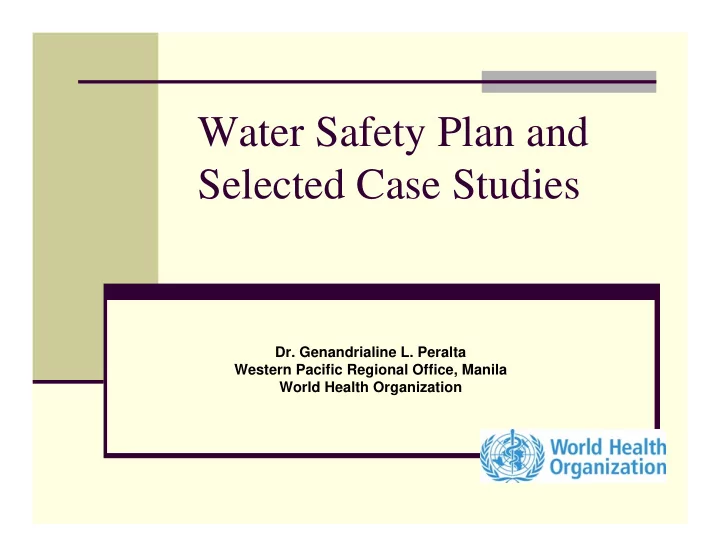

Water Safety Plan and Selected Case Studies Dr. Genandrialine L. Peralta Western Pacific Regional Office, Manila World Health Organization The views expressed in this paper are the views of the authors and do not necessarily reflect the views or policies of the Asian Development Bank (ADB), or its Board of Directors, or the governments they represent. ADB does not guarantee the accuracy of the data included in this paper and accepts no responsibility for any consequences of their use. Terminology used may not necessarily be consistent with ADB official terms.
Water contaminated by pathogenic microbes and chemicals can transmit disease � Unsafe water, together with inadequate sanitation and hygiene, is the overwhelming contributor to the 4 billion illnesses and 1.8 million deaths caused by diarrhoea every year. Around 90% of this toll is borne by children under five. Every diarrhea episode reduces calorie and nutrient uptake and sets back a child's growth and development.
Water safety can prevent waterborne diseases � Water safety can be assured through a variety of interventions at the level of households, community, water supplier and regulator, often with an excellent cost-benefit ratio. � WHO estimates that 94% of diarrhea cases are preventable through modifications to the environment, including increased availability of clean water.
WHO Harmonized Framework Traditional approach Curative, reactive Water Safety Plans Preventive, proactive
Framework for Safe Drinking-water Framework for Safe Drinking-water Health-based targets Public health context and health outcome Water Safety Plans System Management & Monitoring Assessment Communication Surveillance
Important Modern Concepts of WSPs � Prevent contamination, don’t wait for it to happen � Notification comes in time � E.g chlorine residual monitoring on line � If residual drops a correction is applied � Consumers are protected � Same principle applies to all processes � Risks are managed by control processes � Use multiple barriers so that if one barrier fails the water stays safe � Use management systems to make water safety management reliable � Every improvement is worth it and helps improve public health
Pacific Water Safety Planning
WSPs Process Control Watershed Consumer Watershed Consumer Initial Initial Output Output Input Input WQ WQ Barrier n Barrier 1 Barrier 2 WQ Barrier n Barrier 1 Barrier 2 WQ Final Final Input Input Output Output WQ WQ WQ WQ Hazards Hazards Consumers Supplier
System flow diagrams – WSP Maynilad, Philippines DESCRIPTION STEP RESPONSIBILTY Multiple Stakeholder (NPC, Catchment (Angat Dam) DENR, MWSS, NIA, NWRB) Natural and Human DENR, NPC, MWSS, NWRB Activity Primary Storage Utility (NPC) Transport (Gravity flow to Ipo, Bicti and MWSS, MWSI, MWCI, CPF Aqueducts) Legal and Illegal Connections Splitting of Raw Water Common Purpose Facilities Flow (Portal) Raw Water Transmission from Portal Weir to Water Production, MWSI LP 1&2
Pacific Water Safety Planning – Draft DWSPs developed System Description NATIONAL DRINKING WATER SAFETY PLAN PROGRAMME REPUBLIC OF PALAU DRINKING WATER SAFETY PLAN FOR KOROR AIRAI WATER SUPPLY Cover Page from Koror-Airai DWSP, Palau This document was compiled by the Palau Water Safety Plan National Steering Committee on behalf of the Ministry of Lands and Resource Development. The Ministry of Lands and Resource Development is responsible for the Schematic for implementation and oversight of this plan. Waila Treatment This plan is due for revision March 2008. Plant,, Fiji
WSPs Download Water safety plans: Managing drinking-water quality from catchment to consumer http://www.who.int/water_sanitation_health/dwq/wsplans/en/ http://www.who.int/water_sanitation_health/dwq/wsp0506/en/index.html � WHO information products on water, sanitation, hygiene and health can be freely downloaded at: http://www.who.int/water_sanitation_health/ � Acknowledgements to Mr Terrence Thompson, WHO WPRO; Mr Steven Iddings, WHO Suva; Mr Francisco Arellano, Maynilad Water Supply Inc; Dr Jamie Bartram, WHO Geneva, and Dr Annette Davison and Dr Daniel Deere, Water Futures, Australia
Recommend
More recommend